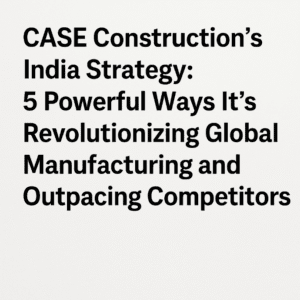CASE Construction’s India Strategy: 5 Powerful Ways It’s Revolutionizing Global Manufacturing and Outpacing Competitors
CASE Construction Equipment is using its Pithampur facility in India as a strategic hub for innovation, cost efficiency, and export resilience. By aligning with India’s CEV5 emission standards, CASE has unlocked global markets like Europe and South Korea, treating regulatory compliance as a design advantage. The facility’s flexibility allows for last-minute customizations, ensuring scalability and agility in meeting diverse market needs.
With a focus on deep localization and lifecycle value, CASE balances cost with quality in price-sensitive markets. India’s political stability, skilled labor, and competitive wages make it a strong alternative to China for global supply chains. CASE also leverages IoT for predictive maintenance, despite some adoption challenges in India. The company’s focus on compact machines and rural-urban connectivity projects highlights its forward-thinking approach to emerging markets.
Overall, CASE’s India strategy exemplifies how emerging markets can lead in high-tech manufacturing through adaptability, innovation, and regulatory foresight.

CASE Construction’s India Strategy: 5 Powerful Ways It’s Revolutionizing Global Manufacturing and Outpacing Competitors
As global manufacturing grapples with geopolitical shifts and tightening emissions standards, CASE Construction Equipment, part of CNH Industrial, is charting an unconventional path by positioning India as its linchpin for innovation, cost efficiency, and export resilience. A closer look at their Pithampur facility reveals a strategic playbook that transcends mere compliance—a model blending regulatory foresight, modular engineering, and cultural adaptability. Here’s how India is reshaping CASE’s global footprint and what it means for the future of construction equipment.
- Regulatory Foresight: Turning CEV5 Compliance Into a Global Export Catalyst
India’s CEV5 emission norms, now on par with Europe’s Stage V standards, have forced domestic manufacturers to rethink engine design and aftertreatment systems. But CASE is leveraging this mandate as a springboard for global relevance. By aligning its India-made machinery with advanced emission standards, the company has unlocked access to markets like Europe, Israel, and South Korea.
Key Insight: Unlike competitors who view compliance as a cost burden, CASE treats it as a design philosophy. Their CEV5-compliant machines (like backhoe loaders and compactors) share a common structural platform, allowing modular tweaks for market-specific needs—whether adjusting emission controls for Europe or enhancing durability for Southeast Asia’s rugged terrains. This “one-quality” approach ensures scalability without diluting performance.
- The Flexibility Factor: India’s Unmatched Production Agility
The Pithampur plant’s standout feature isn’t its scale—it’s its ability to pivot. Emre Karazli, CNH’s APAC VP, highlights how the facility accommodates last-minute order changes and customizations, a rarity in heavy equipment manufacturing. While Western factories operate with rigid “frozen periods” (no design changes post-planning), CASE India’s leaner workflows allow late-stage modifications, catering to niche demands from markets like Australia or New Zealand.
Why It Matters: This agility stems from a hybrid of skilled labor, localized supply chains, and a workforce ethos willing to adapt overnight. For instance, technicians often re-tool production lines within hours to meet urgent export orders—a flexibility that’s made India CNH’s primary APAC sourcing hub (80% of regional needs).
- Cost vs. Quality: A Delicate Balance in Price-Sensitive Markets
The transition to CEV5 tech has raised equipment costs by 8–12%, a challenge in India’s price-conscious market. However, CASE is countering this through:
- Deep Localization: 85% of components are sourced domestically, insulating against forex volatility.
- Fuel Efficiency: CEV5 machines save 2–3 liters of diesel/hour, offsetting upfront costs over time.
- Grassroots Training: Programs like Shilpi (technician upskilling) and Hunar (operator training) ensure customers maximize machine lifespan.
The Bigger Picture: While rivals cut corners, CASE bets on lifecycle value. Their IoT-enabled engines, for example, enable predictive maintenance, reducing downtime—a critical edge for infrastructure projects racing against deadlines.
- India vs. China: Redrawing Global Supply Chains
CNH’s Indian operations now split revenue evenly between domestic sales and exports—a stark contrast to China, where production primarily serves local demand. Labor costs are part of the story (Indian wages are 4–5x lower), but policy stability and talent availability also play roles.
Strategic Edge: India’s CEV5 alignment lets CASE sidestep the “China+1” supply chain chaos. With North America and Europe wary of over-reliance on Chinese manufacturing, India emerges as a politically neutral, high-quality alternative.
- IoT and the Indian Customer: Bridging the Adoption Gap
While CASE’s machines come equipped with telematics for real-time monitoring (fuel use, GPS, fault codes), only 30% of Indian customers renew IoT subscriptions after the first year. Small contractors often dismiss it as a “premium feature,” preferring reactive fixes over predictive maintenance.
CASE’s Workaround: The company maintains backend connectivity to track critical failures, even if users opt out. This “invisible” IoT layer allows dealers to pre-emptively dispatch technicians, subtly shifting customer behavior toward proactive upkeep.
- Future-Proofing: Compact Machines and Untapped Markets
CASE’s upcoming mini excavators and skid-steer loaders target urbanization trends in India and abroad. Mini excavators, for instance, cater to tight spaces in cities and small-scale farming—a segment growing at 9% annually in Asia. Meanwhile, government projects like Bharat Mala and North-East roadworks are driving demand in previously overlooked regions.
Expanding Reach: With 60+ domestic dealers and partnerships in Africa and the Middle East, CASE is doubling down on rural-urban connectivity projects. Their Indore parts hub (stocking ₹100 crore in inventory) ensures <48-hour delivery, even in remote areas.
The Takeaway: India as a Global Manufacturing Archetype
CASE’s India strategy isn’t just about cost arbitrage—it’s a holistic ecosystem play. By integrating regulatory compliance, modular design, and workforce culture, the Pithampur facility exemplifies how emerging markets can lead in high-tech manufacturing. For global OEMs, the lessons are clear:
- Regulations as Innovation Drivers: Use local mandates to future-proof products for global markets.
- Flexibility Over Scale: Agile, adaptive factories outperform rigid mass-production models.
- Ecosystem Overhauls: Invest in grassroots training and digital tools to elevate entire value chains.
As CASE prepares to launch CEV5 machines globally, its India blueprint offers a roadmap for turning regulatory challenges into export opportunities—a case study in pragmatic globalization.
You must be logged in to post a comment.